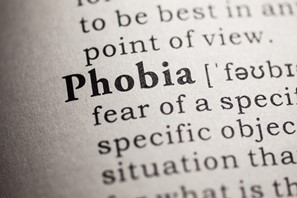Specific Phobia
Advanced Therapeutic Solutions for Anxiety provides therapy for the treatment of Specific Phobias.
Specific phobia is a marked and persistent fear or anxiety triggered by the presence of a specific object (e.g., spiders, insects, dogs), natural environment (e.g., heights, storms, water), or health/medical procedures (e.g., fear of blood, injections, transfusions, other medical care, or fear of injury) classified as blood-injection-injury phobia. The fear can also be situational (e.g., airplanes, elevators, enclosed spaces). Other phobias can also be considered a specific phobia. For example, in children, there may be a fear of loud sounds (e.g., balloons popping, glass breaking) or costumed characters (e.g., clowns).
The phobic object or situation almost always triggers immediate fear, and if it can’t be avoided, then it is endured with intense fear or anxiety. The indidividual may recognize that their fear is out of proportion to the actual danger posed, but when they are faced with the object or situation, they still overestimate the danger in that moment, activating the fear response. People with specific phobias actively avoid the phobia. For example, a person who fears flying turns down jobs that require travel. A child with fear of thunderstorms stays in the basement until the thunderstorm passes. A teen afraid of enclosed spaces takes the stairs instead of elevators.
If you are nodding your head reading this, you’re not alone. Specific phobias affect 7%-9% of the US population (1 in 11-14 people), with 5% prevalence in children (1 in 20) and 16% in teens (1 in 6). If you have a specific phobia, chances are you have more than one. About 75% of people with specific phobias fear more than one object or situation, wih the average being three feared objects/situations. A specific phobia can develop after:
- Experiencing or witnessing a traumatic event (e.g., being attacked by a dog), including extensive media coverage of a traumatic event (e.g., plane crashing into the Twin Towers, stories of COVID-19 patients dying)
- Having an unexpected and sudden panic attack in the to-be-feared situation (e.g., a panic attack while riding the bus, getting blood drawn, getting a COVID-19 test)
A lot of times, however, the individual cannot pinpoint the cause. What is more apparent is the active avoidance of the feared object or situation, and the significant anxiety (ranging from anxiety atack to full-blown panic attack) that the phobic stimulus causes when it can’t be avoided.
Specific phobias are treated with exposure therapy with response prevention (ERP). The individual is presented with the phobic stimulus in successive, graduated steps, activating the fear response just enough to retrain the brain, but not overwhelm you. Cognitive-behavioral strategies, such as psychoeducation of the thoughts-emotion-behavior triad (CBT) and mindfulness (ACT) are used to activate the new learning and deepen fear extinction.
Clinical Procedures for Specific Phobia Evaluation and Outpatient Treatment
Free Phone Intake Consultation
Up to 30-min phone consultation so we can hear about your presenting issue, the symptoms you are experiencing, when they started, the severity of symptoms, and if we are the appropriate place for your treatment. The diagnostic intake process is discussed, and your insurance/billing questions are answered. If the treatment you need is within our scope of services, we begin the scheduling process. If it is deemed that we are not the appropriate place, we will provide you with referrals and resources to help you. We want to make sure to connect you with services, and that includes helping you find treatment elsewhere if that's what you need.
Free
CPT CODE: 0
Diagnostic Evaluation
A 90-min diagnostic intake interview with the child’s parents to assess symptoms, collect history, review systems (school, home, community), differential diagnosis, review of prior records, review parents’ families psychiatric histories, and follow up/clarify any questions that arose from reviewing the questionnaires parents/child/teen filled out before the intake session.
Starting at 295
CPT CODE: 90791
Child Observation and Intervention
Up to 60-min live behavioral observation(s) to assess and quantify the degree of anxiety, allowing us to define a baseline. Using a play-based model, additional questionnaires may be filled out for diagnostic purposes. Interventions are tested out, also using a play-based model, to assess the child's response to intervention for treatment planning purposes.
Starting at 195
CPT CODE: 90837
Child Exposure Therapy Clinic Session
60 min exposure sessions to present the child with the phobic stimulus and begin the process of fear extinction. The key to exposure therapy is to activate new learning, which is done by presenting the child with the phobic stimulus, and assisting the child to approach (vs avoid) the stimulus. Parents are also taught how to facilitate approach coping and reduce enabling avoidance. Your therapist will use modeling, shaping, corrective feedback, and contingent reinforcement with child and parents. Our data show that when parents are involved in treatment, gains are more likely to transfer into the home and community settings.
Starting at 175
CPT CODE: 90837
Child Exposure Therapy in School, Community, or Home Settings
60-min exposure sessions provided in the school, home, or community setting to help transfer treatment gains into these domains. To increase transfer of treatment gains, reduce avoidance of the phobia across settings, and reduce others rescuing the child from approaching the phobia (to rescue them from distress), in-vivo and in-situ exposure therapy is most effective. Not only does the child develop distress tolerance, new learning, and fear extinction, so do the adults in these settings, which helps them reduce rescuing and enabling. We will train school staff on how to appropriately prompt, monitor, and reinforce your child’s approach behavior with guidance via modeling and demonstrating use of skills. Home visits are used to help child and parents use skills at home, and Community sessions provide exposure practice in new settings.
Starting at 185 + travel
CPT CODE: 90837
